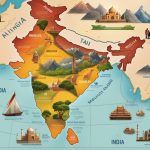Compare living and work between Canada and India with our comprehensive guide. Learn about the differences in salary, cost of living, job opportunities, and more. Make the best decision for your future today!
Are you thinking of moving to Canada or India? Discover the dramatic differences in living and working in these two unique countries. The strong and resource-rich economy of Canada provides stability and a good standard of life, with big companies in technology and aerospace such as Shopify and Bombardier. India, on the other hand, has one of the world’s fastest-growing economies, excelling in IT and pharmaceuticals despite wealth disparity and an informal labor market.
Learn about the work culture, work hours, cost of living, and salary differences between these two different countries.
- Economy
Canada
Canada has a powerful and diverse economy, ranking among the top nations in the world for economic stability and quality of life. Canada’s economy is praised for its durability and resource-rich sectors, with a GDP of more than $2.139 trillion (USD) in 2022. Its abundant natural resources, like as oil, minerals, and lumber, have been critical to its economic success. Furthermore, Canada is an international player in the technology and aerospace industries, with big businesses such as Shopify and Bombardier contributing significantly.
Despite the problems provided by the COVID-19 epidemic, the country’s economic resilience is evident in its low unemployment rate, which is an average of about 5.5% in 2023. The efficient healthcare and education systems of Canada contribute to a trained workforce, which fosters innovation and productivity.
India
On the other hand, India has one of the world’s fastest-growing major economies. India’s economic strength has been largely driven by its enormous population and various industries, with a GDP topping $3.73 trillion in 2022. The country excels in information technology and software services, with companies such as Infosys and Tata Consultancy Services (TCS) leading the way. The thriving pharmaceutical sector in India has also played an important role in world healthcare.
Despite its rapid expansion, India confronts several economic issues, including income inequality and a significant informal labor sector. The country’s unemployment rate, which is 8.1% in 2023, is a source of concern. Initiatives such as “Make in India” and “Digital India,” on the other hand, aim to promote the manufacturing and technology sectors, potentially producing additional job possibilities.
The Indian economy is characterized by innovation, entrepreneurship, and a young labor population. India is a prominent actor in the global economy due to its strategic geographical location and involvement in international trade agreements such as the Regional Comprehensive Economic Partnership (RCEP).
- Cost of living
Canada
Canada is well-known for its high level of life, but it comes with a price. The country has a strong healthcare system, a great education system, and a variety of facilities, yet these benefits are reflected in the costs. Housing expenditures are a major component of Canada’s higher cost of living. Renting a one-bedroom apartment in places like Toronto and Vancouver can easily reach $2,000 per month. Housing is a major expenditure even in smaller towns.
Furthermore, while taxes cover the expense of healthcare, other areas of everyday living, such as food, transportation, and dining out, tend to be costlier in comparison to many other countries. Monthly transportation passes in Toronto, for example, can cost more than $150, while lunch at a mid-range restaurant normally starts at $15.
India
India, on the other hand, is known for its affordability. The cost of living in India is far cheaper, making it a popular choice for expatriates and budget visitors. Housing is substantially less expensive, with one-bedroom homes in major cities like as Mumbai and Delhi costing between $150 and $400 per month. Groceries are inexpensive, and dining out is an inexpensive pleasure. A lunch at a mid-priced restaurant can be as little as $5.
India’s healthcare system is well-known for its affordability and high quality, drawing medical tourists from all over the world. While private healthcare is available, public healthcare is both accessible and cost-effective.
- Healthcare
Canada
Canada’s healthcare system is well-known for its universal coverage, which ensures that all Canadian citizens and permanent residents have access to healthcare services. The government largely supports healthcare through taxation, ensuring that everyone, irrespective of financial standing, has access to critical medical treatments. Preventive care is prioritized in Canada, which minimizes the pressure on hospitals and healthcare expenses in the long run. The World Health Organization (WHO) ranks Canada’s healthcare system 30th in the world in terms of quality and access. Wait times for non-urgent operations might be long, although the overall quality of service is excellent.
India
The healthcare system in India is a combination of public and private providers, and it provides a wide range of medical services. The private healthcare industry in India is well-developed, and people wanting speedier access to specialist treatment frequently select it. However, public healthcare facilities in India can be overcrowded and underfunded. Through efforts such as Ayushman Bharat, which aims to give health coverage to millions of economically deprived residents, the government is attempting to enhance access and quality in the public healthcare sector. The uneven distribution of healthcare resources and quality differences between rural and urban areas pose problems to India’s healthcare system.
- Education
Canada
Canada has a world-class education system that is distinguished for its high quality and inclusiveness. The government makes large investments in education, spending more than 5.17% of its GDP on the field. The University of Toronto and McGill University are two famous examples of Canadian universities that routinely rank among the best in the world.
The emphasis on research and innovation is one of Canada’s primary assets. It houses cutting-edge research facilities and offers several chances for students to participate in research initiatives. The country’s dedication to diversity is mirrored in multicultural classrooms, which provide a dynamic cross-cultural learning experience.
India
India’s wide and diversified educational environment provides an extensive range of educational options. It is home to world-class institutions such as the Indian Institutes of Technology (IITs) and Indian Institutes of Management (IIMs).
The affordability of India’s education system makes it accessible to a wide populace. The country’s emphasis on STEM (Science, Technology, Engineering, and Mathematics) fields has resulted in a talented workforce that makes important contributions to the global IT and engineering industries.
- Work Hours
Canada
In Canada, the regular workweek is 40 hours distributed across five days, Monday through Friday. The normal workday begins at 8:00 a.m. and ends at 9:00 a.m., with considerable flexibility depending on the company and industry. Work-life balance is important to Canadians, and it’s normal for employees to take an hour-long lunch break to recover and frequently spend time with colleagues or engage in other activities. This strategy boosts productivity and employee satisfaction. Furthermore, Canada has been known for being accommodating in terms of flexible work hours and remote work, allowing employees to tailor their schedules to their requirements.
India
Work hours in India vary greatly based on the sector and locality. The typical workweek is 5 to 6 days long, with a total of 40 to 48 hours. In comparison with Canada, work start hours can vary greatly, with some organizations starting as early as 7:00 AM and others beginning as late as 10:00 AM. Food breaks are similarly different with some employees having a quick 30-minute break and others enjoying a longer hour-long meal. India’s work culture frequently emphasizes devotion and long hours, although this is changing as the country adopts more flexible work arrangements, particularly in the IT and technology industries. With the rise of remote work and flexible scheduling, India is progressively adopting a more balanced work-life balance.
- Work Leaves
Canada
Work leaves in Canada are big and vary according to criteria such as province, job contract, and sector. Paid annual leave is a regular perk, with employees being entitled to at least two weeks of paid vacation every year. Many provinces provide extra paid public holidays. Furthermore, Canada has a solid system in place for maternity and paternity leave. In Quebec, for example, new moms can take up to 18 weeks of paid maternity leave, while new dads can take up to 5 weeks of paid paternity leave. This promotes a positive work-life balance.
India
The work leave system in India differs from that in Canada. In addition to public holidays, paid leave rights sometimes include 12 to 15 days of yearly leave. India also offers up to 26 weeks of maternity leave, one of the world’s longest, and promotes family-friendly laws. The actual leave benefits, however, vary significantly based on the business in question and the nature of the job. While leave benefits can’t be as broad as in Canada, the cost of living in India is far cheaper, making it a financially appealing location for many expats.
- Salary
Canada
The average pay in Canada varies greatly depending on numerous factors, including geography, sector, and work function. The national median income is roughly CAD 52,000 per year on average. This amount, however, varies substantially depending on the region or area. Because of their high living costs, large cities such as Toronto and Vancouver, for example, tend to provide greater pay.
In terms of industry, positions in technology, finance, and healthcare are often more lucrative. In Canada, for example, a software engineer can anticipate an annual pay of $75,000 to CAD 100,000, but a registered nurse can expect a salary of $70,000 to CAD 85,000.
India
India, on the other hand, has a far lower average income than Canada. In India, the median yearly salary is roughly 1.5 to 2.5 lakh INR, which converts from approximately $2,000 to USD 3,500. However, because of India’s cheaper cost of living, this salary is sufficient for many people and families.
IT experts in India, particularly in locations such as Bangalore and Hyderabad, tend to earn greater pay. A software engineer in India, for example, might make an average yearly income of 6-10 lakh INR, which is around $8,000 to USD 13,000, or even more in some situations.
Finally, deciding between Canada and India for living and working relies on your priorities and preferences. Canada has a strong and stable economy, as well as excellent educational and healthcare systems, but it has a higher cost of living. On the other side, while India offers low living costs and a growing IT industry, income levels are often lower.
Both countries have distinct benefits and disadvantages, such as work hours and leave rules. Finally, your choice should be based on your job objectives, lifestyle, and financial circumstances. Make an informed decision to successfully mold your future.








































